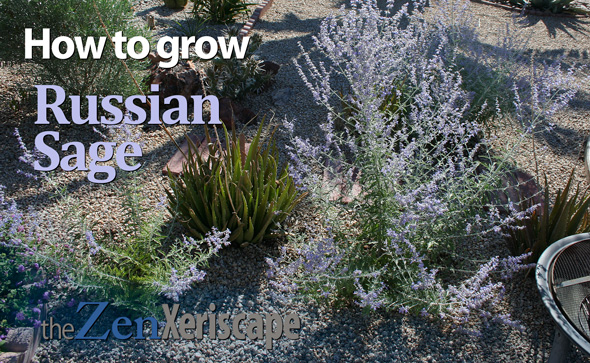This fall, my Orange Jubilee (Tecoma x ‘Orange Jubilee’) is blooming like crazy. Its trumpet-shaped orange flowers create a wall of vibrant color in my xeriscape. While this plant looks good, are there any drawbacks to having this plant in your landscape? Here are the Tecoma Orange Jubilee pros and cons!
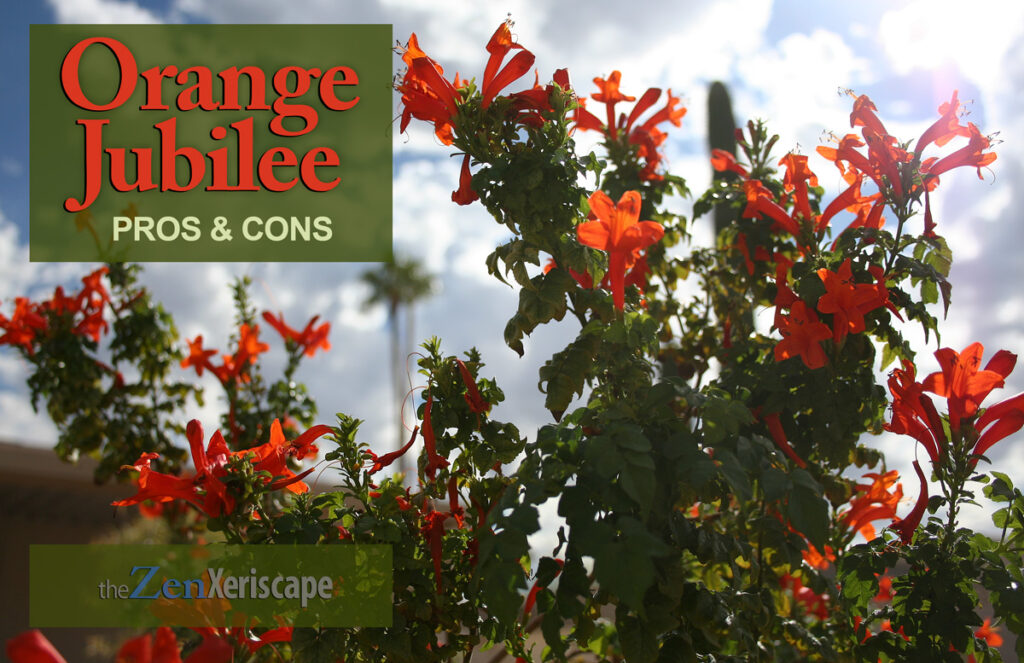
a tropical ambience to any arid landscape.
Here are the Orange Jubilee pros and cons.
Photo by Doug Martin
Orange Jubilee pros and cons
PROS:
Long blooming season
If you live in a frost-free hardiness zone, the Tecoma Orange Jubilee can bloom year-round! The trumpet-shaped flowers are a vibrant orange hue, which contrasts beautifully with the lush, green foliage.
This plant blooms most prolifically in the spring and fall, but also blooms in the summer and winter seasons. During our extremely hot summers in the Phoenix, Arizona region, my Orange Jubille bloomed sparsely, and the vegetation did show signs of stress.
Attractive flowers
The vividly orange flowers are so vibrant, that they appear to create a wall of vibrating color supported by the lush, green foliage. In addition, the flowers are trumpet-shaped, which is a perfect shape for hummingbirds, butterflies, and moths.
In addition, the trumpet-shaped flowers mean they are large, which helps create an even more dynamic impression in what might be an otherwise subdued xeriscape.
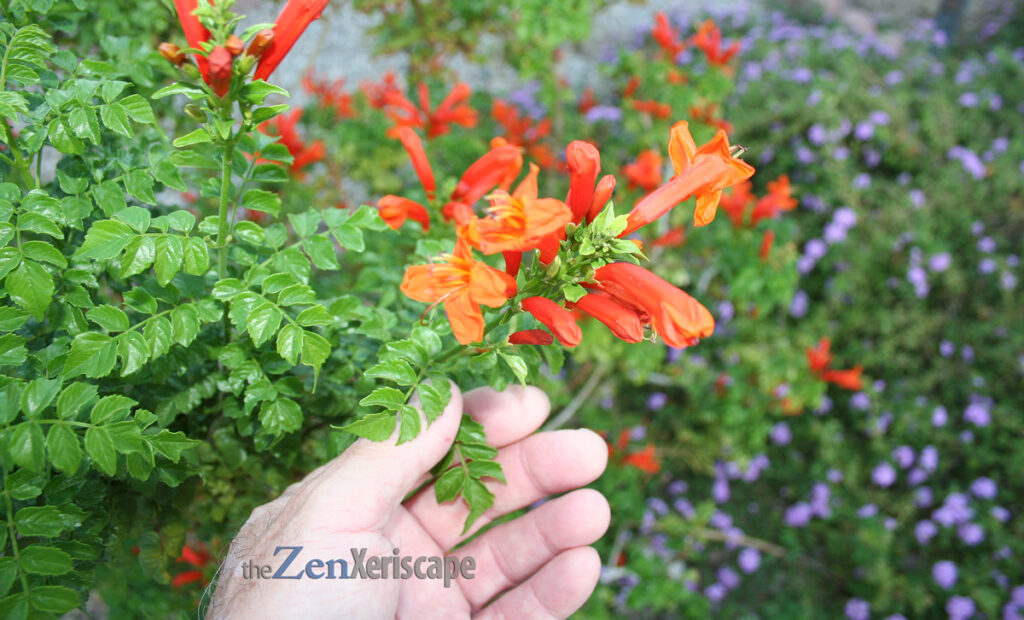
and lushly green vegetation.
Photo by Doug Martin
Grows quickly
The Orange Jubilee is a bush that can grow quickly. In a few years, it can grow up to 15 feet tall, with a width of 8-to-10 feet.
However, I noticed that my Orange Jubilee grew more slowly during the first year in my landscape. But, in the second and third years, it really took off and grew quickly.
Browse pruning shears on Amazon! (As an Amazon Associate, I earn a commission from qualifying purchases.)
Attracts pollinators
Hummingbirds cannot resist the vibrantly orange flowers. In addition to hummingbirds, butterflies, moths, and other pollinators are also attracted to its fragrant and colorful blossoms.
Drought- and heat-tolerant
The Tecoma ‘Orange Jubilee’ is tolerant of the extreme summer heat we get in southern Arizona. However, it does show some signs of stress during extreme heat. For instance, flower production almost stopped and some of the leaf edges turned brown during out last extremely hot southern Arizona summer.
In addition, this lush-looking bush is drought-tolerant, making it an ideal addition to any arid landscape or xeriscape. However, while once-a-week waterings were enough to keep my Orange Jubilee alive, it looked much better when I watered it twice-a-week during our extremely hot summers.
Versatile uses in a landscape
This plan is extremely versatile—you can grow it in your arid-landscape, or put it in a large container or pot with drainage holes.
Here in the southern United States, we can grow it full-time in our garden soil outside. However, during colder winter months, it might require some protection. The advantage of growing this, or any drought-tolerant plant, in a container, is that you can bring it indoors during inclement weather.
Does best in well-draining soil
To insure gardening success with the Tecoma ‘Orange Jubilee’, plant it in soil that drains well. Even though it can tolerate excess water, it does best when the roots do not sit in pooling water.

vibrantly orange flowers.
They contrast beautifully
with the trailing lantana in the background.
Photo by Doug Martin
Orange Jubilee pros and cons
CONS:
Sensitive to freezing temps
Unfortunately, this tropical-looking plant will suffer damage during freezing temperatures. While it can thrive in the USDA hardiness zones of 8-to-11, it could die back to the ground or suffer foliage damage when temps dip below 28 degrees F (-2 degrees C).
In case of night of freezing temps, protect this plant with a frost cloth (see the link below) or other type of blanket. Or, bring your container-bound Orange Jubilee inside for the night!
Fortunately, if this plant does get damaged from a hard-freeze, it will likely grow back from its roots when temperatures warm back up (if you are in hardiness zones of 8-to-11).
Protect your plants from frost damage with a frost blanket. (As an Amazon Associate, I earn a commission from qualifying purchases.)
Sprawling, leggy growth
The Orange Jubilee does grow fast, but it can also quickly produce branches that sprawl along the ground, or grow out at odd angles. That sprawling growth can make it look leggy and unattractive pretty quickly.
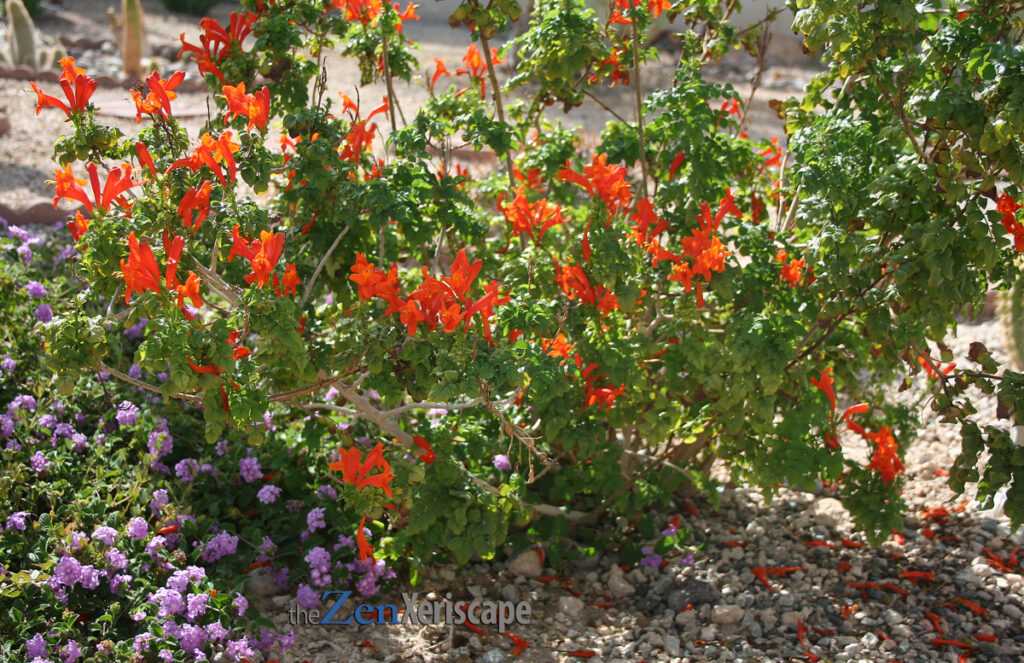
but its growth can be leggy
and sprawl along the base.
Therefore, prune regularly
for best appearance.
Photo by Doug Martin
Requires regular pruning
To counteract its naturally sprawling, leggy growth, regular pruning is best. My hope is to prune off all the branches that sprawl along the ground, and eventually create a wall-like, or even tree-like shrub, with multiple trunks.
Personally, I think this shrub looks best when all the growth is pruned away from the base. The plant looks neater, and more attractive. In addition, you can place smaller flowering plants in the foreground for a lovely contrast.
Flower color might be too vibrant
In my case, I find the beautiful orange flowers to be almost too vibrant in my landscape. The color almost vibrates and kind-of clashes with my other plants.
For example, I have a large, sprawling trailing lantana planted in front of one of my Orange Jubilees. I love how the purple-blue lantana flowers contrast with the lush, green foliage of the Orange Jubilee.
However, when the Orange Jubilee puts out a fresh flush of orange blooms, the orange is almost overpowering, and clashes with the trailing lantana. Normally, purple-blue and orange contrast nicely, but not in this case.
I might have to find another smaller, flowering plant to place in front of my Orange Jubilee. Or, maybe it’s just me—maybe I’m just sensitive to that vividly bright, orange wall of color. I don’t know!
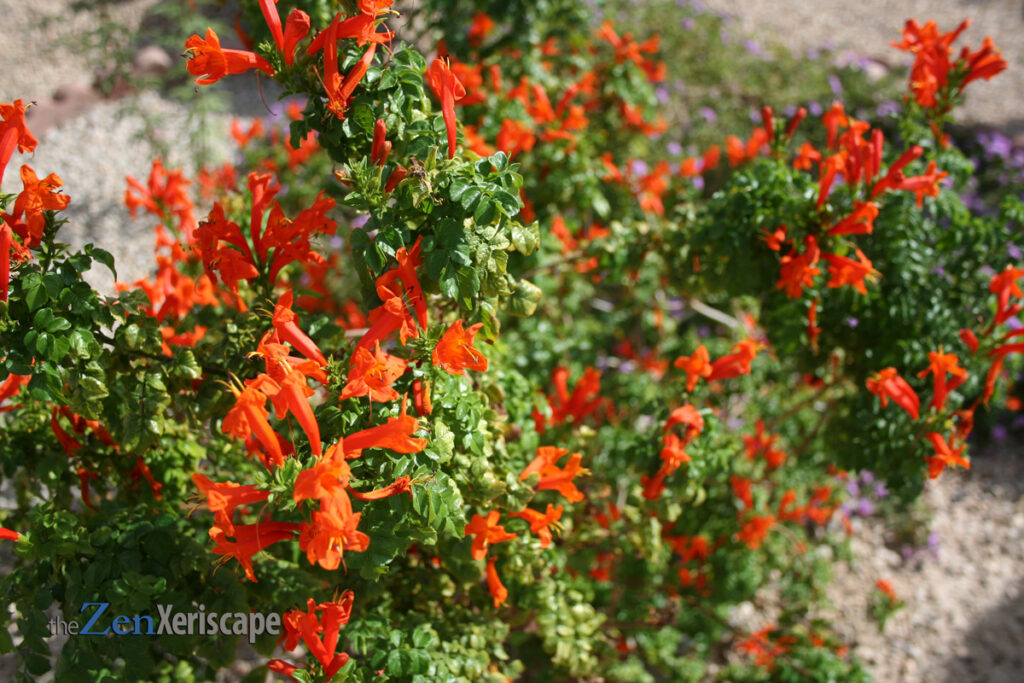
of the Orange Jubilee.
When it’s in full bloom, this plant’s
flowers strike me as being almost too vivid!
Photo by Doug Martin
Susceptible to insect pests
While I’ve never encountered a problem with Orange Jubilee plants, this shrub is susceptible to aphids, spider mites, and whiteflies. The first plan of attack for those insect infestations is to use a pressurized hose, and spray them off the vegetation.
Get live succulent plants on Amazon! (As an Amazon Associate, I earn a commission from qualifying purchases.)
TAKEAWAYS:
Orange Jubilee pros and cons
Orange Jubilee looks good in arid landscape
What’s not to like: The Tecoma ‘Orange Jubilee’ has a lush, tropical look—its flowers are tube-shaped with a vividly bright orange color, and its leaves are a beautifully lush-looking green.
Orange Jubilee is drought-tolerant
In addition, this shrub is drought-tolerant and can even withstand the extreme, southern-Arizona summer heat! And, it grows fast and has many versatile uses in an arid-landscape.
Fast growth requires regular pruning
Unfortunately, its fast, sprawling growth should be pruned regularly to keep an attractive form.
Orange Jubilee is perfect for a xeriscape
Because of all its advantages and its beautifully tropical look, this is a perfect plant to consider adding to your arid landscape.
If you already have the Orange Jubilee in your xeriscape, please share your thoughts and experiences in the comments section below!
Content and photos by Doug Martin and The Zen Xeriscape

For more landscaping ideas, browse landscaping books on Amazon! (As an Amazon Associate, I earn a commission from qualifying purchases.)


